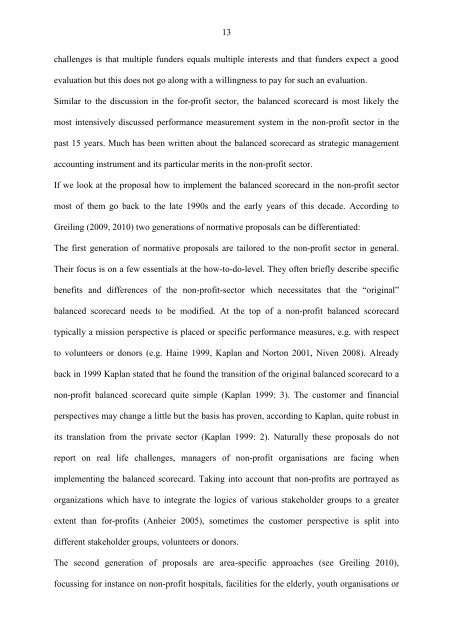Strategic responses to Performance Measurement in Nonprofit ...
Strategic responses to Performance Measurement in Nonprofit ...
Strategic responses to Performance Measurement in Nonprofit ...
You also want an ePaper? Increase the reach of your titles
YUMPU automatically turns print PDFs into web optimized ePapers that Google loves.
13<br />
challenges is that multiple funders equals multiple <strong>in</strong>terests and that funders expect a good<br />
evaluation but this does not go along with a will<strong>in</strong>gness <strong>to</strong> pay for such an evaluation.<br />
Similar <strong>to</strong> the discussion <strong>in</strong> the for-profit sec<strong>to</strong>r, the balanced scorecard is most likely the<br />
most <strong>in</strong>tensively discussed performance measurement system <strong>in</strong> the non-profit sec<strong>to</strong>r <strong>in</strong> the<br />
past 15 years. Much has been written about the balanced scorecard as strategic management<br />
account<strong>in</strong>g <strong>in</strong>strument and its particular merits <strong>in</strong> the non-profit sec<strong>to</strong>r.<br />
If we look at the proposal how <strong>to</strong> implement the balanced scorecard <strong>in</strong> the non-profit sec<strong>to</strong>r<br />
most of them go back <strong>to</strong> the late 1990s and the early years of this decade. Accord<strong>in</strong>g <strong>to</strong><br />
Greil<strong>in</strong>g (2009, 2010) two generations of normative proposals can be differentiated:<br />
The first generation of normative proposals are tailored <strong>to</strong> the non-profit sec<strong>to</strong>r <strong>in</strong> general.<br />
Their focus is on a few essentials at the how-<strong>to</strong>-do-level. They often briefly describe specific<br />
benefits and differences of the non-profit-sec<strong>to</strong>r which necessitates that the “orig<strong>in</strong>al”<br />
balanced scorecard needs <strong>to</strong> be modified. At the <strong>to</strong>p of a non-profit balanced scorecard<br />
typically a mission perspective is placed or specific performance measures, e.g. with respect<br />
<strong>to</strong> volunteers or donors (e.g. Ha<strong>in</strong>e 1999, Kaplan and Nor<strong>to</strong>n 2001, Niven 2008). Already<br />
back <strong>in</strong> 1999 Kaplan stated that he found the transition of the orig<strong>in</strong>al balanced scorecard <strong>to</strong> a<br />
non-profit balanced scorecard quite simple (Kaplan 1999: 3). The cus<strong>to</strong>mer and f<strong>in</strong>ancial<br />
perspectives may change a little but the basis has proven, accord<strong>in</strong>g <strong>to</strong> Kaplan, quite robust <strong>in</strong><br />
its translation from the private sec<strong>to</strong>r (Kaplan 1999: 2). Naturally these proposals do not<br />
report on real life challenges, managers of non-profit organisations are fac<strong>in</strong>g when<br />
implement<strong>in</strong>g the balanced scorecard. Tak<strong>in</strong>g <strong>in</strong><strong>to</strong> account that non-profits are portrayed as<br />
organizations which have <strong>to</strong> <strong>in</strong>tegrate the logics of various stakeholder groups <strong>to</strong> a greater<br />
extent than for-profits (Anheier 2005), sometimes the cus<strong>to</strong>mer perspective is split <strong>in</strong><strong>to</strong><br />
different stakeholder groups, volunteers or donors.<br />
The second generation of proposals are area-specific approaches (see Greil<strong>in</strong>g 2010),<br />
focuss<strong>in</strong>g for <strong>in</strong>stance on non-profit hospitals, facilities for the elderly, youth organisations or
















